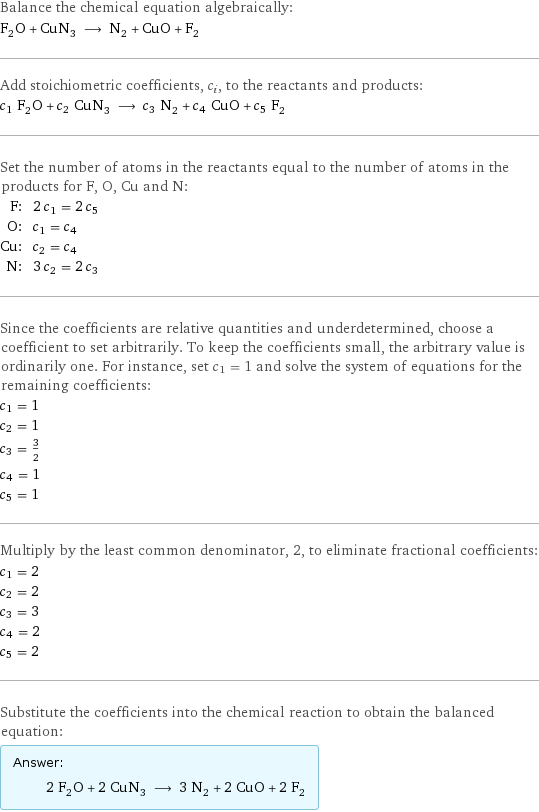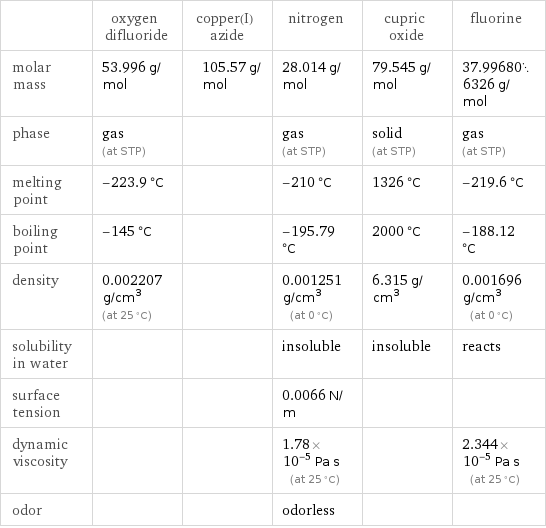Input interpretation

F_2O oxygen difluoride + CuN_3 copper(I) azide ⟶ N_2 nitrogen + CuO cupric oxide + F_2 fluorine
Balanced equation

Balance the chemical equation algebraically: F_2O + CuN_3 ⟶ N_2 + CuO + F_2 Add stoichiometric coefficients, c_i, to the reactants and products: c_1 F_2O + c_2 CuN_3 ⟶ c_3 N_2 + c_4 CuO + c_5 F_2 Set the number of atoms in the reactants equal to the number of atoms in the products for F, O, Cu and N: F: | 2 c_1 = 2 c_5 O: | c_1 = c_4 Cu: | c_2 = c_4 N: | 3 c_2 = 2 c_3 Since the coefficients are relative quantities and underdetermined, choose a coefficient to set arbitrarily. To keep the coefficients small, the arbitrary value is ordinarily one. For instance, set c_1 = 1 and solve the system of equations for the remaining coefficients: c_1 = 1 c_2 = 1 c_3 = 3/2 c_4 = 1 c_5 = 1 Multiply by the least common denominator, 2, to eliminate fractional coefficients: c_1 = 2 c_2 = 2 c_3 = 3 c_4 = 2 c_5 = 2 Substitute the coefficients into the chemical reaction to obtain the balanced equation: Answer: | | 2 F_2O + 2 CuN_3 ⟶ 3 N_2 + 2 CuO + 2 F_2
Structures

+ ⟶ + +
Names

oxygen difluoride + copper(I) azide ⟶ nitrogen + cupric oxide + fluorine
Equilibrium constant
![Construct the equilibrium constant, K, expression for: F_2O + CuN_3 ⟶ N_2 + CuO + F_2 Plan: • Balance the chemical equation. • Determine the stoichiometric numbers. • Assemble the activity expression for each chemical species. • Use the activity expressions to build the equilibrium constant expression. Write the balanced chemical equation: 2 F_2O + 2 CuN_3 ⟶ 3 N_2 + 2 CuO + 2 F_2 Assign stoichiometric numbers, ν_i, using the stoichiometric coefficients, c_i, from the balanced chemical equation in the following manner: ν_i = -c_i for reactants and ν_i = c_i for products: chemical species | c_i | ν_i F_2O | 2 | -2 CuN_3 | 2 | -2 N_2 | 3 | 3 CuO | 2 | 2 F_2 | 2 | 2 Assemble the activity expressions accounting for the state of matter and ν_i: chemical species | c_i | ν_i | activity expression F_2O | 2 | -2 | ([F2O])^(-2) CuN_3 | 2 | -2 | ([CuN3])^(-2) N_2 | 3 | 3 | ([N2])^3 CuO | 2 | 2 | ([CuO])^2 F_2 | 2 | 2 | ([F2])^2 The equilibrium constant symbol in the concentration basis is: K_c Mulitply the activity expressions to arrive at the K_c expression: Answer: | | K_c = ([F2O])^(-2) ([CuN3])^(-2) ([N2])^3 ([CuO])^2 ([F2])^2 = (([N2])^3 ([CuO])^2 ([F2])^2)/(([F2O])^2 ([CuN3])^2)](../image_source/c564fd5274e2094c9c9af40cf0016663.png)
Construct the equilibrium constant, K, expression for: F_2O + CuN_3 ⟶ N_2 + CuO + F_2 Plan: • Balance the chemical equation. • Determine the stoichiometric numbers. • Assemble the activity expression for each chemical species. • Use the activity expressions to build the equilibrium constant expression. Write the balanced chemical equation: 2 F_2O + 2 CuN_3 ⟶ 3 N_2 + 2 CuO + 2 F_2 Assign stoichiometric numbers, ν_i, using the stoichiometric coefficients, c_i, from the balanced chemical equation in the following manner: ν_i = -c_i for reactants and ν_i = c_i for products: chemical species | c_i | ν_i F_2O | 2 | -2 CuN_3 | 2 | -2 N_2 | 3 | 3 CuO | 2 | 2 F_2 | 2 | 2 Assemble the activity expressions accounting for the state of matter and ν_i: chemical species | c_i | ν_i | activity expression F_2O | 2 | -2 | ([F2O])^(-2) CuN_3 | 2 | -2 | ([CuN3])^(-2) N_2 | 3 | 3 | ([N2])^3 CuO | 2 | 2 | ([CuO])^2 F_2 | 2 | 2 | ([F2])^2 The equilibrium constant symbol in the concentration basis is: K_c Mulitply the activity expressions to arrive at the K_c expression: Answer: | | K_c = ([F2O])^(-2) ([CuN3])^(-2) ([N2])^3 ([CuO])^2 ([F2])^2 = (([N2])^3 ([CuO])^2 ([F2])^2)/(([F2O])^2 ([CuN3])^2)
Rate of reaction
![Construct the rate of reaction expression for: F_2O + CuN_3 ⟶ N_2 + CuO + F_2 Plan: • Balance the chemical equation. • Determine the stoichiometric numbers. • Assemble the rate term for each chemical species. • Write the rate of reaction expression. Write the balanced chemical equation: 2 F_2O + 2 CuN_3 ⟶ 3 N_2 + 2 CuO + 2 F_2 Assign stoichiometric numbers, ν_i, using the stoichiometric coefficients, c_i, from the balanced chemical equation in the following manner: ν_i = -c_i for reactants and ν_i = c_i for products: chemical species | c_i | ν_i F_2O | 2 | -2 CuN_3 | 2 | -2 N_2 | 3 | 3 CuO | 2 | 2 F_2 | 2 | 2 The rate term for each chemical species, B_i, is 1/ν_i(Δ[B_i])/(Δt) where [B_i] is the amount concentration and t is time: chemical species | c_i | ν_i | rate term F_2O | 2 | -2 | -1/2 (Δ[F2O])/(Δt) CuN_3 | 2 | -2 | -1/2 (Δ[CuN3])/(Δt) N_2 | 3 | 3 | 1/3 (Δ[N2])/(Δt) CuO | 2 | 2 | 1/2 (Δ[CuO])/(Δt) F_2 | 2 | 2 | 1/2 (Δ[F2])/(Δt) (for infinitesimal rate of change, replace Δ with d) Set the rate terms equal to each other to arrive at the rate expression: Answer: | | rate = -1/2 (Δ[F2O])/(Δt) = -1/2 (Δ[CuN3])/(Δt) = 1/3 (Δ[N2])/(Δt) = 1/2 (Δ[CuO])/(Δt) = 1/2 (Δ[F2])/(Δt) (assuming constant volume and no accumulation of intermediates or side products)](../image_source/c11aace8a51f624b12be79f55ee5a637.png)
Construct the rate of reaction expression for: F_2O + CuN_3 ⟶ N_2 + CuO + F_2 Plan: • Balance the chemical equation. • Determine the stoichiometric numbers. • Assemble the rate term for each chemical species. • Write the rate of reaction expression. Write the balanced chemical equation: 2 F_2O + 2 CuN_3 ⟶ 3 N_2 + 2 CuO + 2 F_2 Assign stoichiometric numbers, ν_i, using the stoichiometric coefficients, c_i, from the balanced chemical equation in the following manner: ν_i = -c_i for reactants and ν_i = c_i for products: chemical species | c_i | ν_i F_2O | 2 | -2 CuN_3 | 2 | -2 N_2 | 3 | 3 CuO | 2 | 2 F_2 | 2 | 2 The rate term for each chemical species, B_i, is 1/ν_i(Δ[B_i])/(Δt) where [B_i] is the amount concentration and t is time: chemical species | c_i | ν_i | rate term F_2O | 2 | -2 | -1/2 (Δ[F2O])/(Δt) CuN_3 | 2 | -2 | -1/2 (Δ[CuN3])/(Δt) N_2 | 3 | 3 | 1/3 (Δ[N2])/(Δt) CuO | 2 | 2 | 1/2 (Δ[CuO])/(Δt) F_2 | 2 | 2 | 1/2 (Δ[F2])/(Δt) (for infinitesimal rate of change, replace Δ with d) Set the rate terms equal to each other to arrive at the rate expression: Answer: | | rate = -1/2 (Δ[F2O])/(Δt) = -1/2 (Δ[CuN3])/(Δt) = 1/3 (Δ[N2])/(Δt) = 1/2 (Δ[CuO])/(Δt) = 1/2 (Δ[F2])/(Δt) (assuming constant volume and no accumulation of intermediates or side products)
Chemical names and formulas

| oxygen difluoride | copper(I) azide | nitrogen | cupric oxide | fluorine formula | F_2O | CuN_3 | N_2 | CuO | F_2 name | oxygen difluoride | copper(I) azide | nitrogen | cupric oxide | fluorine IUPAC name | fluoro hypofluorite | | molecular nitrogen | | molecular fluorine
Substance properties

| oxygen difluoride | copper(I) azide | nitrogen | cupric oxide | fluorine molar mass | 53.996 g/mol | 105.57 g/mol | 28.014 g/mol | 79.545 g/mol | 37.996806326 g/mol phase | gas (at STP) | | gas (at STP) | solid (at STP) | gas (at STP) melting point | -223.9 °C | | -210 °C | 1326 °C | -219.6 °C boiling point | -145 °C | | -195.79 °C | 2000 °C | -188.12 °C density | 0.002207 g/cm^3 (at 25 °C) | | 0.001251 g/cm^3 (at 0 °C) | 6.315 g/cm^3 | 0.001696 g/cm^3 (at 0 °C) solubility in water | | | insoluble | insoluble | reacts surface tension | | | 0.0066 N/m | | dynamic viscosity | | | 1.78×10^-5 Pa s (at 25 °C) | | 2.344×10^-5 Pa s (at 25 °C) odor | | | odorless | |
Units
